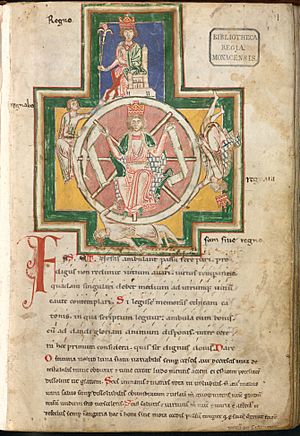Carmina Burana facts for kids
Carmina Burana is a famous collection of old poems and songs. These texts were written a long time ago, mostly in the 11th century and 12th century. There are more than 240 different texts in this collection. Most of them are in Latin, which was the language of scholars back then. Some are also in Middle High German, an older form of the German language.
Many of these texts talk about what is right and wrong, or they make fun of things in a clever way. Others are about the beauty of spring or the feelings of love. You can also find fun drinking songs and special Minnesang (German love songs) in the collection. Some of these songs even have clues about their original tunes, and some of those tunes can still be figured out today!
Contents
When and Where Carmina Burana Was Written
The texts of Carmina Burana were written down around the year 1230. Historians believe this happened in a monastery in Styria or close to Brixen. These places are in what is now Austria and Italy.
How Carmina Burana Was Found
The collection was hidden away for many centuries. It was finally discovered in 1803 by a person named Johann Christoph von Aretin. He found the texts at the Benediktbeuern Abbey in Germany. Today, this important collection is kept safe in the Bavarian State Library in Munich. There, it is known as the Codex Buranus.
The Music of Carmina Burana
Later, a scholar named Johann Andreas Schmeller studied these texts. He put them together and published them as Carmina Burana – Lieder aus Benediktbeuern.
Much later, in the 20th century, a famous composer named Carl Orff became interested in the texts. He chose 24 of the poems and wrote new music for them. This musical work is also called Carmina Burana. It was first performed in 1937 at the Opera house in Frankfurt am Main, Germany.
Carl Orff also created two other musical works, Catulli Carmina and Trionfo di Afrodite. He combined all three into a larger work called Trionfi. However, the Carmina Burana by itself is much more famous and performed more often than the full Trionfi.
Images for kids
See also
 In Spanish: Carmina Burana para niños
In Spanish: Carmina Burana para niños





